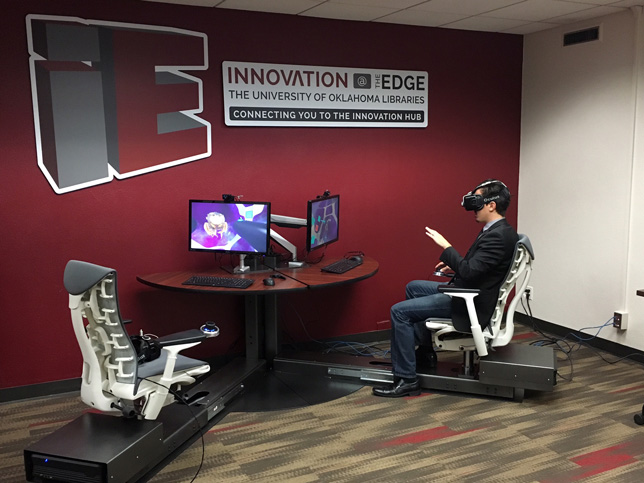A Hub for Innovation and Learning
A dedicated space in the University of Oklahoma's Bizzell Memorial Library connects community members to cutting-edge digital tools they can use in new learning experiences and innovative knowledge creation.
Category: Education Futurists
Institution: University of Oklahoma
Project: Innovation @ the Edge
Project lead: Matt Cook, head of emerging technologies, Knowledge Services
Tech lineup: Google Cardboard, Hatchbox, HTC Vive, Leap Motion, Lulzbot, MakerBot, Nvidia, Oculus Rift, Raspberry Pi, Sparkfun, Unity
The University of Oklahoma has built an inclusive, technology-rich space called Innovation @ the Edge (IE), where faculty, staff, students and other members of the university community may use technologies like virtual reality, 3D printing, visualization, software carpentry, microcontrollers and other new and emerging tools for innovative knowledge creation and learning. Housed in the school's Bizzell Memorial Library, the facility serves as an "intellectual crossroads" where ideas and technology come together.

Project lead Matt Cook
Project lead Matt Cook, OU Libraries' head of emerging technologies, and his colleagues in Knowledge Services have been testing and refining the concept of the IE space since its opening in January 2016. Broader goals for the space include: 1) bringing the campus user community from separate colleges together so they can collaborate — both virtually and in an attractive and challenging physical space — on higher achievements in teaching, learning and research; and 2) giving students the opportunity to work with the latest technologies in their regular coursework.
As Cook commented, "The Innovation @ the Edge space is now a regular part of the coursework offered by many colleges across campus. In these cases, faculty are doing more than merely exposing students to emerging technologies — they are incorporating in-depth assignments and modules into teaching that relies upon virtual reality, 3D printing, microcontrollers, robotics [and more]. This is also important because engagement with the library — along with its spaces, tools, and expertise — has become central to the undergraduate experience as a result of the Edge's success."
A key aspect of the success Cook refers to is the power of the technologies within the IE space to afford the kind of knowledge creation and sharing that gives the community a fuller library experience, by leveraging the resources and expertise found in the library and throughout the colleges on campus.
For example, in conjunction with the university's 125th anniversary, OU Libraries developed and featured an exhibit of highly valued university resources called "Galileo's World." The exhibit included an impressive VR station that became a popular and productive experience for both students and campus visitors. In another program, OU Libraries found a cost-effective way to enhance the functionality of its 3D printing tools such that local middle school students could 3D scan museum artifacts, 3D print them, and explore the printed items "hands-on" in ways that could not be allowed with the original objects in a museum setting.
After more than a year in service, the IE space is being used creatively by a wide cross section of colleges and faculty are incorporating assignments that use the space in ways that extend the reach of campus and departmental learning resources. While libraries are traditionally thought of as a place of books and serials that contain information, the IE space demonstrates that information can also expressed as 3D prints, virtual reality models, research data and/or visualizations of that data, microcontrollers that can be easily built and rebuilt by others to duplicate research results, and software carpentry to program those microcontrollers. All these and more are valid forms of creating and expressing information.

OU's Innovation @ the EDGE space exposes students to virtual reality and other emerging technologies in a hands-on environment.
Many technologies have been used in the development and operation of the IE space over time. Initially, to create the facility's first virtual reality area, named OVAL, the IE team acquired some early Oculus Rift virtual reality headsets, Leap Motion detectors, Unity software, PCs assembled by students, and a sliding chair workstation designed by a team member and built by the physics department.
A variety of related technologies and products — Google Cardboard and HTC Vive among them — were explored and employed over time in order to extend the reach and add other functionalities provided by those products. The team started out with MakerBot for 3D printing but ultimately moved on to Lulzbot to support the "open" approach preferred by OU Libraries. A few products, like Nvidia graphics cards (to support virtual reality), the Hatchbox 3D printer filament, Raspberry Pi microcontrollers, and Sparkfun electronics kits were particularly noted by the team for their usefulness in supporting the goals of the IE. Innovation @ the Edge continues to expand into the use of new and interesting tools, reflecting a broadening of its scope as the technology landscape continually changes over time.
It's "business as usual" for the Knowledge Services librarians to look forward to change. Innovation @ the Edge is one of several University of Oklahoma initiatives that put the library at the heart of the university — a central place where the work of the institution is accomplished and where the ideas from the various colleges are combined, refined and extended as a result of collaboration and cooperation. The librarians seek to further OU's larger strategic goals by continuing to scan the horizon for emerging technologies that may represent the next level of technology change in support of the pedagogical and research goals of the university.
Return to Campus Technology Impact Awards Home